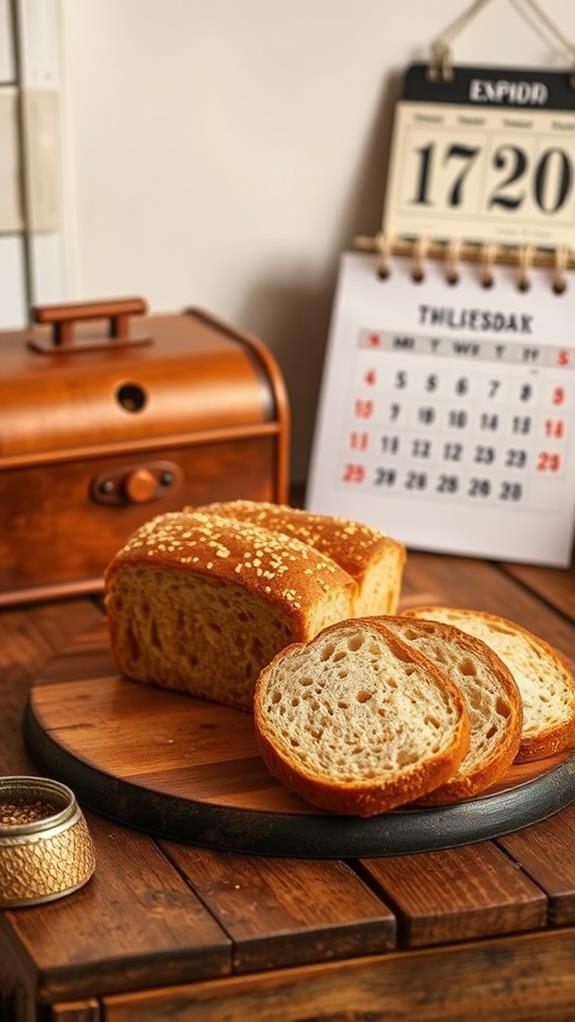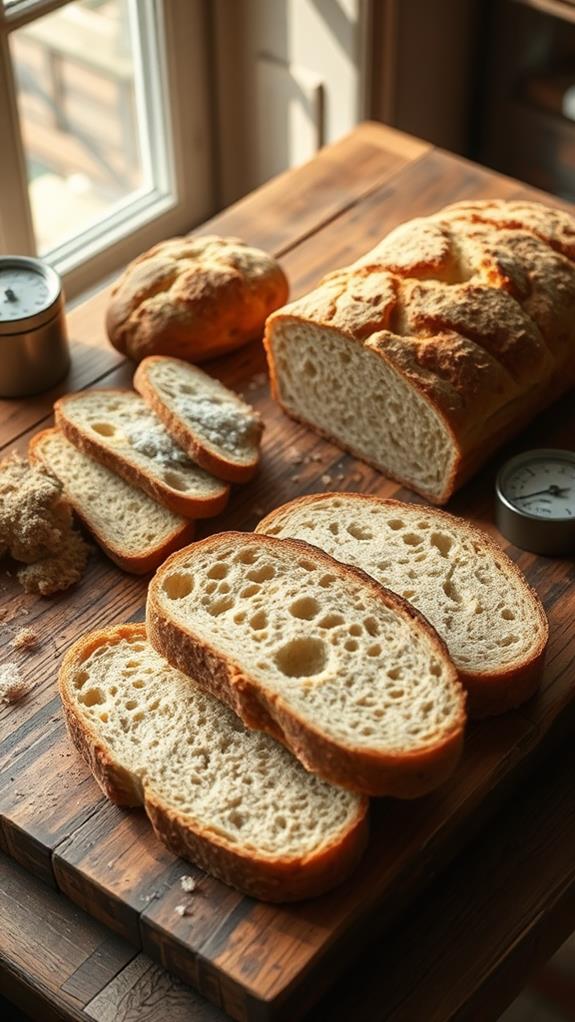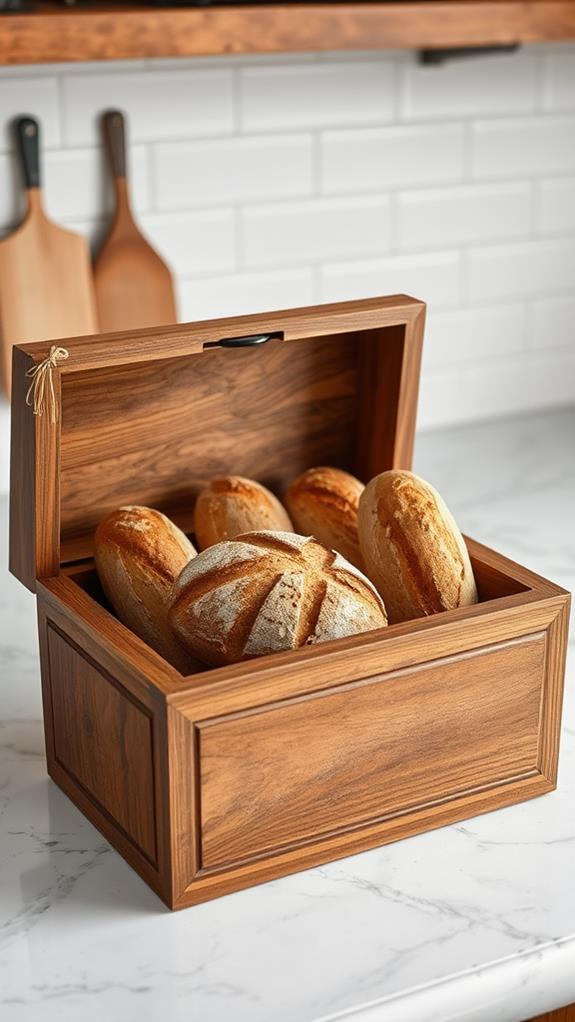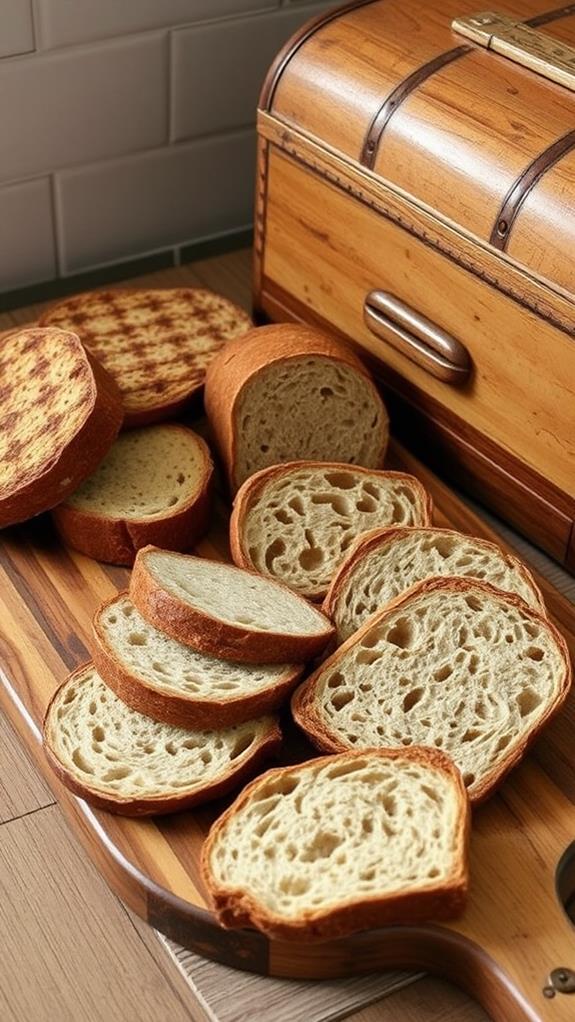Is Expired Bread Safe to Eat
Expired bread isn't automatically unsafe to eat, but you'll need to carefully assess its condition. Don't rely solely on the printed date; instead, look for signs of spoilage like visible mold, off-odors, or unusual textures. Factors such as storage conditions and bread type affect shelf life. While consuming slightly stale bread is generally harmless, eating moldy bread can lead to food poisoning. To extend your bread's lifespan, store it properly in a cool, dry place or freeze it. Remember, expiration dates are conservative estimates, so use your senses to determine if bread is still good. Proper understanding of bread storage and spoilage can help you reduce waste and make informed decisions about consumption.
This post may contain affiliate links. If you make a purchase through these links, I may earn a commission at no additional cost to you. Additionally, portions of this post may be generated using artificial intelligence (AI) technology. While we strive for accuracy, please be aware that AI-generated content may not always be perfect and should be fact-checked when necessary.
The Spatula Scoops
- Expired bread is not necessarily unsafe, but visual and olfactory cues are more reliable indicators of spoilage than printed dates.
- Visible mold, sour odor, unusual texture, or off-flavors are clear signs that bread should be discarded.
- Eating moldy bread can lead to food poisoning due to mycotoxins and harmful bacteria, even if not visibly contaminated.
- Proper storage in cool, dry conditions can extend bread's shelf life beyond the printed expiration date.
- Toasting or baking does not make moldy or contaminated bread safe to eat; discard any bread showing signs of spoilage.
Understanding Bread Expiration Dates

Three key dates often appear on bread packaging: the sell-by date, best-by date, and use-by date. It's essential to understand what these mean for your bread's freshness and safety. The sell-by date is primarily for retailers, indicating when they should remove the product from shelves. You'll often find bread still edible after this date. Similar to oatmeal expiration dates, these dates can be somewhat misleading and don't always indicate immediate spoilage.
The best-by date suggests when the bread will be at its peak quality. It's not a safety date but rather a recommendation for optimal taste and texture. You can typically consume bread shortly after this date without issues. The use-by date, however, is more stringent. It's the manufacturer's estimate of the last day the bread is suitable to eat.
Keep in mind that these dates aren't foolproof. Factors like storage conditions and whether the package has been opened can affect bread's longevity. To maximize shelf life, store bread in a cool, dry place or freeze it. Always check for visible mold or off-odors before consumption, regardless of the date on the package. These visual and olfactory cues are often more reliable indicators of bread safety than printed dates.
Signs of Spoiled Bread
While understanding expiration dates is helpful, knowing how to spot spoiled bread is even more important for your safety. You'll want to use your senses to identify signs of spoilage. Look for visible mold, which can appear as green, blue, or white fuzzy spots on the bread's surface. Smell the bread; if it has a sour or musty odor, it's likely gone bad. The texture can also indicate spoilage; if your bread feels unusually hard, dry, or sticky, it's best to discard it.
Here's a quick reference table for identifying spoiled bread:
| Sense | Signs of Spoilage | Action |
|---|---|---|
| Sight | Mold, discoloration | Discard |
| Smell | Sour or musty odor | Discard |
| Touch | Hard, dry, or sticky | Evaluate carefully |
| Taste | Off-flavor or sourness | Stop eating immediately |
Factors Affecting Bread Shelf Life

Before you consider eating expired bread, it is necessary to understand the factors that influence its shelf life. The longevity of your bread depends on several key elements, including its ingredients, storage conditions, and packaging.
Ingredient composition plays a pivotal role. Breads with preservatives tend to last longer than those without. Moisture content is another critical factor; the more moisture present, the quicker mold can grow. You'll find that drier breads, like crackers or breadsticks, have extended shelf lives compared to softer varieties. Similar to tofu storage techniques, proper bread storage is indispensable for maintaining quality and safety.
Storage conditions greatly impact bread's freshness. Temperature, humidity, and light exposure all affect how quickly your bread deteriorates. You should store bread in a cool, dry place away from direct sunlight. Refrigeration can extend shelf life but may alter texture, while freezing is an excellent option for long-term storage.
Packaging also matters. Airtight containers or bags help prevent moisture loss and protect against contaminants. However, if you're storing freshly baked bread, allow it to cool completely before sealing to avoid trapping excess moisture.
Lastly, the baking method influences shelf life. Sourdough breads, due to their acidity, tend to last longer than other types.
Risks of Eating Expired Bread
When you're considering eating expired bread, you should be aware of several potential risks. The most significant concerns include the growth of mold and the production of mycotoxins, which can lead to food poisoning and other health issues. Similar to uncooked rice risks, expired bread can harbor harmful bacteria that may cause gastrointestinal distress. Proper storage and handling of bread are vital to minimize these risks. Additionally, as bread ages past its expiration date, its nutritional value gradually decreases, potentially reducing the benefits you'd normally get from consuming fresh bread.
Mold and Mycotoxins
One of the biggest risks associated with eating expired bread is the potential presence of mold and mycotoxins. These toxic compounds are produced by certain types of fungi that can grow on bread when it's past its prime. You might not always see visible mold, but that doesn't mean it's not there. Mycotoxins can cause various health issues, ranging from mild digestive discomfort to more severe problems.
When examining expired bread, look out for these signs of mold:
- Fuzzy spots of green, blue, or white
- Discolored areas or dark spots
- Unusual odors
- Slimy or sticky texture
If you notice any of these indicators, it's best to discard the bread immediately. Don't try to salvage moldy bread by cutting off affected areas, as mold can spread invisibly throughout the loaf. Even if you can't see mold, it's essential to remember that mycotoxins can still be present. These toxins are heat-resistant, so toasting or baking moldy bread won't make it safe to eat. To protect yourself from potential health risks, it's always better to err on the side of caution and avoid consuming bread that's considerably past its expiration date.
Food Poisoning Potential
Occasionally, eating expired bread can lead to food poisoning, even if there's no visible mold. This is because harmful bacteria can grow on bread without causing noticeable changes in appearance or smell. Pathogens like Bacillus cereus and Staphylococcus aureus thrive in moist environments and can multiply rapidly at room temperature.
It bears emphasis that consuming bread contaminated with these bacteria puts you at risk of developing symptoms such as nausea, vomiting, diarrhea, and abdominal cramps. The severity of food poisoning can vary, but it's particularly dangerous for those with weakened immune systems, young children, and the elderly. It's crucial to understand that toasting expired bread doesn't necessarily kill all harmful bacteria.
To minimize your risk, always store bread properly in a cool, dry place or in the freezer. Pay attention to expiration dates and use your senses to check for any off-odors or unusual textures. If you're unsure about the safety of your bread, it's best to err on the side of caution and discard it. Remember, the potential health risks outweigh any financial savings from consuming expired bread.
Nutritional Value Degradation
Three key nutrients begin to degrade as bread expires: vitamins, proteins, and carbohydrates. As time passes, these essential components break down, reducing the overall nutritional value of your bread. You'll notice that stale bread often feels drier and harder, indicating a loss of moisture and changes in its structural integrity.
The degradation process affects various aspects of the bread's nutritional profile:
- Vitamin content decreases, particularly B vitamins
- Protein structures may break down, affecting digestibility
- Carbohydrates can become less easily metabolized
- Fiber content may diminish slightly
While these changes don't necessarily make the bread unsafe to eat, they do impact its nutritional quality. The longer bread sits past its expiration date, the more pronounced these effects become. You might find that expired bread doesn't provide the same energy boost or satiety as fresh bread due to these alterations in its nutrient composition.
It's important to note that the rate of nutrient degradation can vary depending on storage conditions. Proper storage in a cool, dry place can slow this process, helping to maintain the bread's nutritional value for a longer period.
Proper Bread Storage Techniques

To maximize your bread's shelf life, you'll want to focus on creating ideal storage conditions. This means keeping your bread in a cool, dry place away from direct sunlight and heat sources. You can use airtight containers or plastic bags to protect your bread from moisture and air exposure, which can accelerate staleness and mold growth.
Ideal Storage Conditions
Storing bread properly can substantially extend its shelf life and maintain its quality. To achieve ideal storage conditions, you'll want to focus on four key factors:
- Temperature: Keep bread at room temperature or slightly cooler
- Humidity: Maintain moderate humidity levels
- Air circulation: Minimize exposure to air
- Light exposure: Store in a dark place
You'll find that a bread box or cloth bag is an excellent choice for storing bread, as they allow for some air circulation while protecting against excessive moisture. If you don't have these options, you can use a plastic bag with a few small holes punched in it. This method creates a microclimate that's beneficial for bread preservation.
For longer-term storage, you might consider freezing your bread. Wrap it tightly in plastic wrap or aluminum foil before placing it in a freezer bag. This technique prevents freezer burn and maintains the bread's texture. When you're ready to use it, simply thaw it at room temperature or toast it directly from frozen.
Packaging and Containers
While ideal storage conditions are important, the packaging and containers you use play a key role in preserving your bread's freshness. To maximize shelf life, you'll want to choose the right storage method based on your bread type and consumption timeline.
For short-term storage, paper bags are a good option. They allow moisture to escape, preventing mold growth. However, bread will dry out faster in paper. Plastic bags, on the other hand, trap moisture, which can lead to mold but keeps bread soft longer. If you're using plastic, look for resealable bags to maintain freshness.
For longer storage, consider investing in a bread box. These containers allow for air circulation while protecting bread from environmental factors. Ceramic or wooden boxes are particularly effective at regulating humidity. If you're freezing bread, use airtight freezer bags or containers to prevent freezer burn.
When storing sliced bread, interleave parchment paper between slices to prevent sticking. For artisanal loaves, store them cut-side down on a cutting board, covering the exposed end with a clean kitchen towel. This method balances moisture retention and crust crispness.
Types of Bread and Expiration
Different types of bread have varying shelf lives and expiration patterns. You'll find that commercially produced white bread typically lasts longer than artisanal or homemade varieties due to preservatives. Whole grain breads, which contain more oils, tend to spoil faster than their refined counterparts.
When considering bread expiration, keep these factors in mind:
- Ingredients: Higher moisture content leads to quicker spoilage
- Processing methods: Industrial bread often includes mold inhibitors
- Storage conditions: Humidity and temperature greatly affect shelf life
- Packaging: Airtight containers extend freshness
Sourdough bread, with its natural acidity, can last longer than other types. Rye bread also has a longer shelf life due to its lower pH. On the other hand, gluten-free breads often expire more quickly because they lack the structure provided by gluten.
Understanding these variations can help you make informed decisions about bread consumption past the printed date. Remember, expiration dates are often conservative estimates. Use your senses to determine if bread is still safe to eat, looking for visible mold, off-odors, or unusual textures. When in doubt, it's best to err on the side of caution and discard questionable bread.
Reducing Bread Waste

With a clear understanding of bread expiration, you can now focus on reducing waste. To minimize bread spoilage, store it properly in a cool, dry place. If you've got extra bread, consider freezing it. You'll extend its shelf life considerably, and it'll be ready for toasting or thawing when needed.
Get creative with stale bread. Don't toss it out; instead, repurpose it. You can make croutons, breadcrumbs, or French toast. Stale bread is perfect for dishes like bread pudding or panzanella salad. These techniques not only reduce waste but also add variety to your meals.
Plan your bread consumption. Buy only what you'll use within a few days, or opt for smaller loaves. If you're consistently throwing out bread, reassess your purchasing habits. Consider alternatives like buying half loaves or visiting bakeries more frequently for fresher bread.
Lastly, if you can't use the bread yourself, consider donating it to local food banks or composting it. Many communities have food sharing programs where you can give away excess bread before it spoils. By implementing these strategies, you'll dramatically reduce your bread waste and contribute to a more sustainable food system.
Frequently Asked Questions
Can Expired Bread Be Used for Non-Food Purposes?
Yes, you can repurpose expired bread for non-food uses. It's an excellent option for crafts, like making ornaments or bird feeders. You'll find it useful for cleaning, too – stale bread can absorb grease stains or polish silverware. In gardening, it's a natural fertilizer when composted. Artists often use it for paper mache projects. Remember, while these uses are vital to guarantee the bread isn't moldy before repurposing. Always prioritize safety when exploring alternative uses for expired food items.
How Does Altitude Affect Bread Expiration?
Altitude can affect your bread's expiration in several ways. At higher elevations, you'll notice that bread tends to dry out faster due to lower air pressure and humidity. This can accelerate the staling process, potentially shortening its shelf life. Additionally, the reduced atmospheric pressure might cause bread packaging to expand, potentially compromising its seal. To combat these effects, you may need to store your bread more carefully, using airtight containers or freezing it to maintain freshness longer in high-altitude environments.
Is It Safe to Feed Expired Bread to Animals?
Did you know that approximately 40% of all food in the US goes to waste? When it comes to feeding expired bread to animals, you should exercise caution. While some animals may tolerate it, mold on stale bread can be harmful. It's best to avoid giving expired bread to pets or livestock. Instead, consider composting bread that's past its prime. This way, you're reducing waste and creating nutrient-rich soil for your garden.
Can Expired Bread Be Composted?
Yes, you can compost expired bread. It's an excellent way to recycle food waste and enrich your soil. When composting bread, you'll want to break it into smaller pieces to speed up decomposition. Add it to your compost bin along with other organic materials. Remember, bread is considered a "green" material, so balance it with "brown" materials like leaves or paper. Be aware that bread might attract pests, so bury it well within your compost pile to minimize this risk.
Are There Any Cultural or Religious Views on Consuming Expired Bread?
You'll find that cultural and religious views on consuming expired bread vary widely. Some traditions emphasize avoiding waste, encouraging the use of stale bread in recipes like French toast or bread pudding. In certain religions, bread holds symbolic significance, and consuming expired bread might be seen as disrespectful. However, many cultures prioritize food safety above all else. It's best to research specific cultural or religious practices if you're concerned about adhering to particular beliefs regarding expired bread consumption.
Conclusion
As you navigate the labyrinth of bread consumption, remember that expiration dates are more guideposts than iron-clad rules. Trust your senses—they're your compass in this journey. While stale bread may be a disappointment, it's rarely dangerous. Proper storage is your shield against spoilage, and understanding different bread types is your map to longer freshness. By being mindful of these factors, you'll reduce waste and make the most of every loaf, ensuring your bread basket remains a symbol of nourishment, not neglect.





